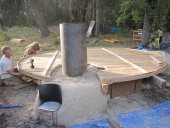posted 3 years ago
I don't really have a perfect answer, and I'm no expert. But my understanding is that it's more usual for soils to have clay than not, especially at the subsoil level. The exception could be old river beds and glacial areas - they're more sand and silt. Chances are you'd need to buy in sand rather than clay, and sand is available at anywhere that sells building stuff. I don't know that beach sand is good for building anyway as it could be worn too smooth. You need sharp sand for building.
The topsoil, the good dark stuff that's great for growing plants, has too much organic material and silt in it to be good for building. So you scrape that off and set that aside for growing plants after the building is done. The subsoil is what you use for building.
Depending how thick your walls are, how many doors and windows you want to include, and how deep you need to make foundations where you build, it's possible that you may get enough clay-content soil from digging out for the foundations. Or you may need to dig a nice hole that could later become a pond. You're unlikely to need to dig lots of huge holes, as you'll be adding plenty of straw and sand to your subsoil which will bulk it up quite a lot, and doors and windows will reduce the volume of cob, as well. Cob is very forgiving, the mix doesn't have to be exactly right.
But my feeling is that when thinking about building, rather than planning what we'll build, we need to wait and see what the land tells us should be built. Each place will have some building materials more available than others, each climate will have building styles that are better suited. If you know you really want to build in cob, then seek out areas that have other cob builders already there. That tells you the soil and climate are suitable.
I'm only 65! That's not to old to learn to be a permie, right?






